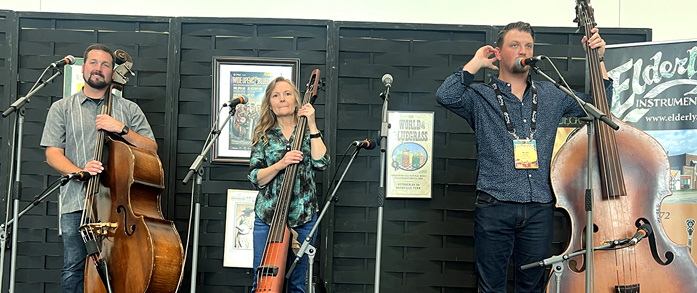
Zak McLamb, Jeanette Williams, and Wyatt Harman at the 2024 bass workshop – photo © Sandy Hatley
“Normally, you don’t have three bass players at one time, but each of our styles will be demonstrated,” began Wyatt Harmon, upright bassist from St. Louis.
The IBMA Bluegrass Live! Saturday afternoon workshop kicked off with Zak McLamb of Alan Bibey & Grasstowne and Caroline & New Company on the doghouse, and Jeanette Williams of Shelton & Williams on the NS electric stick bass, joining Harmon on the Convention Center lobby stage. The trio launched into a rousing rendition of Blackberry Blossom, taking turns holding down the rhythm as Wyatt’s dad, Bull, picked the lead on guitar.
Each player brought their own skills to the table.
Williams explained, “I’m a singer. I play bass out of necessity, the elementary way. I’m the most BASS-ic!”
Harmon then empathized, “Singing and playing the bass is a totally different ballgame.”
“The NS has a totally different sound. Mine and Zak’s are acoustic. I play with a thud. Zac has a classical (music) left hand.”
The trio began with the elementary basics of their instruments.
Zak explained, “Bluegrass bass uses 1,5 terminology. The first string is 1 (G) and the second string is 5 (D), that makes the open G chord. To play the second string as 1 (D) and the third string as 5 (A) makes an open D chord. It’s the lowest four strings on the guitar.”
“I learned that when I was seven years old. My daddy played banjo and bought Mama a bass. I liked it better than she did, and started playing three-chord songs with Daddy. Then I took classical instruction in school.”
Harmon pointed out, “When you play an A, you can play it three different ways. We like to bounce from high, mid, to low. When I play a low A, I really pull it for emphasis. Mid lets the A string ring out more. As you play, go back and forth (between the different ways).”
Zak agreed. “I like the variety. You can use low or high notes to emphasize parts of the melody. It’s appropriate to play the low note as the last note in the song.”
Williams said, “I typically play with a closed hand due to my dexterity. I have small hands.”
Since the doghouses and the stick bass are fretless, Harmon stressed that the left hand needs to be on the right spot.
“Don’t slip or fall. Tone is everything. Use the left hand to mute. Snap the fingers of the right hand to get to the next note.”
“When you don’t mute the strings, the notes run together. You can mute with the right hand, but it gets real busy,” said McLamb.
Next the upright bassists discussed the number of fingers that they use to pluck the strings.
“I play with one finger,” McLamb shared. “And use two fingers when it is really fast.”
Harmon added, “Zak is really precise and clear. I’m heavy with it. I play with two fingers right off the bat.”
One attendee questioned the players, “What part of the right hand finger do you use?”
McLamb replied, “I’ll answer your question with a question. Does it matter which pick you use on guitar? Of course it does. Your finger is your pick, and you don’t have to pay for it…like a Blue Chip!”
Harmon teased, “You pay for it with blisters!”
McLamb highlighted, “The most important thing is to play in time. If you play a wrong note, continue to play notes rather than stop. If you don’t, it starts to fall apart. What you do on the bass makes a big difference in the total package.”
“You almost lead from behind. You set the root chord.”
Harmon agreed. “We want to come in with a punch. E is the lowest note on the bass. We like those low tones like the E note.”
Another attendee asked about slapping the bass.
Harmon shared, “I normally don’t slap. That has never been my style.”
McLamb chimed in, “I don’t hear that (slapping). Doing it all the time loses its effect, almost like being shot with a machine gun. Mike Bub does a cool job of inserting some then right back out. He pulls the string, makes a snap, then a slap.”
Practice makes perfect.
“You build strength in your fingers. My left hand stretches farther than my right because of years of practice. My left arm is like Popeye’s,” Harmon joked. “If you play bass, you get to suffer. You have to carry around this big thing, and your fingers are going to bleed. You’re going to have sore fingers.”
Next, bass strings were discussed.
“We recommend steel strings,” Harmon said.
McLamb added, “It is expensive and time-consuming to try out different strings.”
Zak wrapped up the session with an admission. “Be as lazy as you can. The Lord blessed me with big hands and it makes classical chording easier,” demonstrating that he can play low, mid, and high B-chord positions, all without moving his hand.









